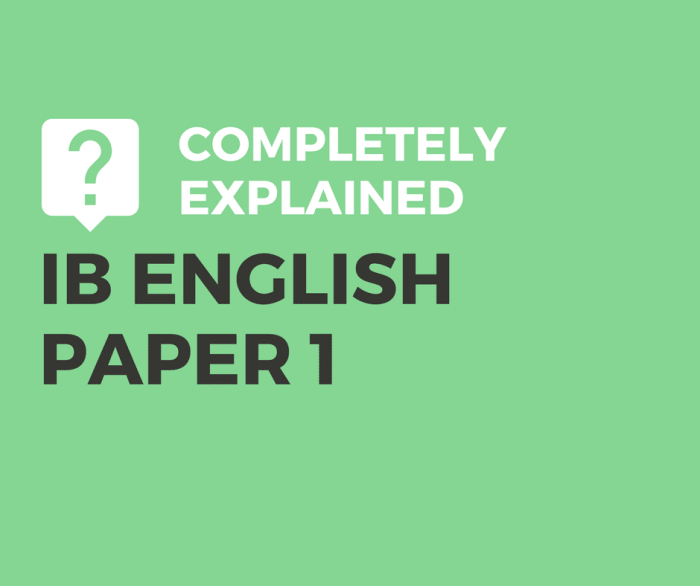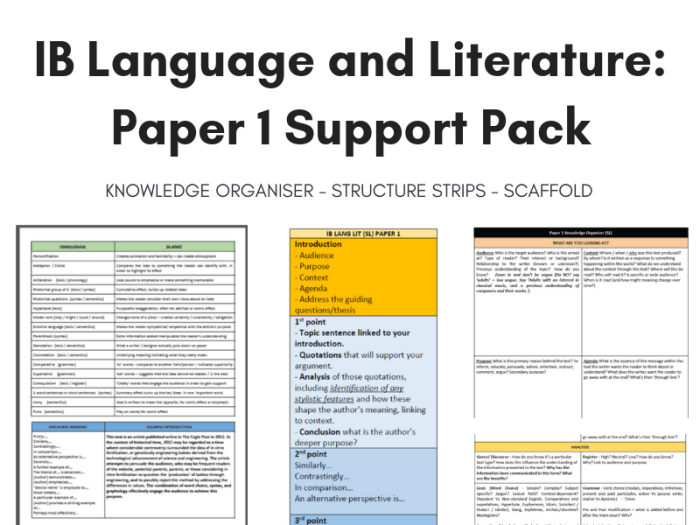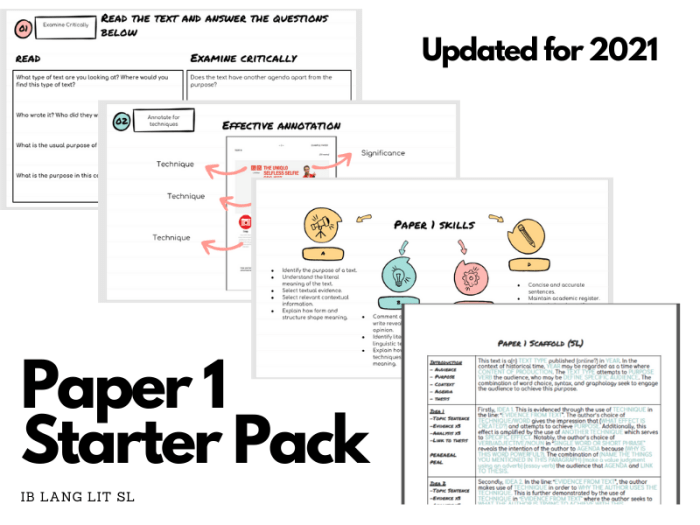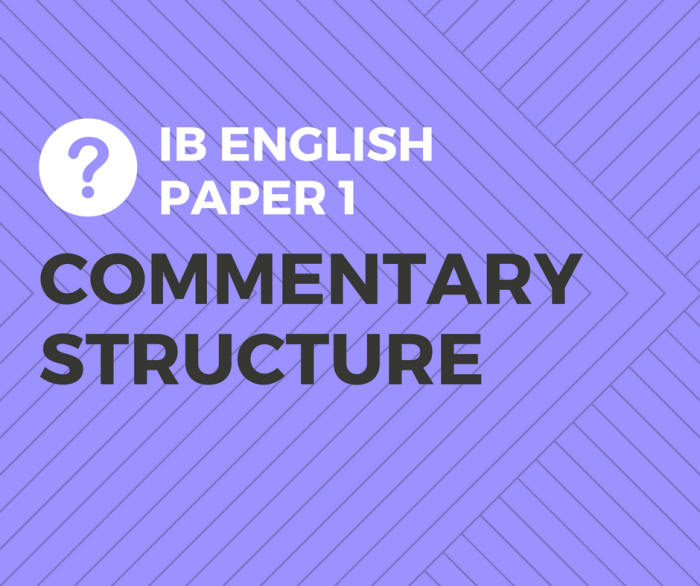IB Lang and Lit Paper 1 embarks on an enlightening journey, delving into the intricacies of textual analysis, contextual understanding, and critical thinking. This comprehensive guide equips you with the essential knowledge and strategies to excel in this challenging assessment.
The second paragraph provides a concise overview of the paper’s structure, key concepts, and the significance of critical analysis.
Paper Structure and Format
Paper 1 of the IB Language and Literature exam consists of two sections:Section A: Textual Analysis (75 minutes)
- Analyze an unseen text (either literary or non-literary)
- Answer two questions, one on content and one on language and style
Section B: Comparative Commentary (75 minutes)
- Compare two texts that share a common theme or issue
- Answer one question that explores the similarities and differences between the texts
Time management is crucial, as you have only 75 minutes for each section. Aim for 45 minutes for Section A and 30 minutes for Section B.Formatting and referencing requirements are essential. Use clear and concise language, and cite sources accurately using the IB referencing system.
Textual Analysis

Textual analysis in Paper 1 involves a comprehensive examination of unseen texts, focusing on language, structure, and themes. By understanding these elements, students can effectively interpret and evaluate the meaning and significance of the text.
To effectively analyze language, pay attention to word choice, sentence structure, and tone. Consider how the author uses specific words and phrases to convey ideas, create imagery, and establish a particular tone. Analyze the sentence structure to identify the types of sentences used and how they contribute to the flow and rhythm of the text.
Structure
Analyze the structure of the text, including its organization, paragraphing, and any other formal elements. Identify the main ideas and supporting details, and examine how they are arranged to create a coherent and cohesive whole.
Themes
Uncover the underlying themes of the text. These are the central ideas or messages that the author is trying to convey. Consider the text’s overall purpose and how the language, structure, and characters contribute to the development of these themes.
Literary Devices, Ib lang and lit paper 1
Identify and analyze the use of literary devices, such as metaphors, similes, imagery, and symbolism. Explain how these devices enhance the meaning and impact of the text. Discuss how they contribute to the creation of tone, mood, or atmosphere.
Contextual Analysis
Contextual analysis is a crucial aspect of Paper 1, as it provides a deeper understanding of the text by examining its historical, cultural, and social context. It helps students interpret the text accurately and appreciate its significance.
To conduct contextual analysis, research the author’s background, the time period in which the text was written, and the social and political climate of that era. Analyze how these factors influenced the author’s perspective and the themes explored in the text.
Connecting Textual and Contextual Analysis
Connect textual analysis with contextual understanding by identifying references to historical events, cultural norms, or social issues in the text. Consider how these references contribute to the meaning and interpretation of the text. Explore how the author’s personal experiences or societal influences may have shaped the text’s themes and characters.
Comparative Analysis

Comparative analysis in Paper 1 involves examining and comparing two or more texts from different perspectives to identify similarities, differences, and patterns. Its purpose is to enhance your critical thinking and analytical skills, enabling you to draw meaningful connections and interpretations between texts.
Identifying Similarities and Differences
When comparing texts, focus on their themes, structures, language, and techniques. Identify areas where the texts align or contrast, considering both explicit and implied meanings. Look for similarities in plot, characterization, symbolism, or literary devices.
Differences may emerge in perspective, style, tone, or the way ideas are presented. By analyzing these variations, you can uncover the authors’ intentions and the unique contributions of each text.
Pattern Recognition
Comparative analysis also involves identifying patterns across texts. These patterns can reveal recurring motifs, symbols, or narrative structures that connect the texts on a deeper level. By recognizing patterns, you can gain insights into the broader literary or cultural contexts in which the texts were created.
Critical Thinking and Interpretation

Critical thinking is paramount in Paper 1, enabling you to engage with texts deeply and develop insightful interpretations.
To develop personal interpretations, analyze texts closely, considering their language, structure, and context. Support your interpretations with evidence from the text and justify your reasoning.
Evaluating and Synthesizing Information
Evaluating information from multiple sources is crucial. Consider the reliability, relevance, and potential biases of each source. Synthesize information by identifying common themes and drawing connections between different perspectives.
Sample Responses and Analysis: Ib Lang And Lit Paper 1
In Paper 1 of IB Lang and Lit, crafting high-quality responses is paramount. This section provides exemplars and analyzes different approaches to textual analysis, offering valuable tips for enhancing writing style and argumentation.
Strengths and Weaknesses of Textual Analysis Approaches
Textual analysis approaches vary in their strengths and weaknesses. The close reading approach, which focuses on meticulously examining the text’s language, imagery, and structure, excels in revealing the author’s craft and intent. However, it may overlook broader contextual influences.
In contrast, the contextual approach, which considers the text’s historical, social, and cultural context, provides a deeper understanding of the work’s meaning and significance. Yet, it risks neglecting the text’s intrinsic qualities.
IB Lang and Lit Paper 1 can be a daunting task, but it doesn’t have to be. One way to make it easier is to break down the task into smaller parts. For example, if you’re struggling to convert 946 ml to cups, you can use this helpful resource: how many cups is 946 ml . Once you’ve broken down the task, you can start to tackle it piece by piece.
And before you know it, you’ll have mastered IB Lang and Lit Paper 1.
A balanced approach that combines close reading with contextual analysis offers a comprehensive understanding of the text. By considering both the text’s internal elements and its external influences, this approach can uncover the work’s multifaceted nature.
Tips for Improving Writing Style and Argumentation
Enhancing writing style and argumentation is crucial in Paper 1. Here are some tips:
- Use precise and vivid language that conveys ideas clearly and effectively.
- Structure arguments logically, providing evidence and examples to support claims.
- Avoid colloquialisms and informal language, maintaining a formal and academic tone.
- Proofread carefully for grammatical errors, typos, and inconsistencies.
Exam Preparation

Preparing for Paper 1 of the IB Lang and Lit exam requires a multifaceted approach that encompasses understanding the paper structure, honing analytical skills, and developing critical thinking abilities. This guide will provide key strategies, practice questions, and insights to help you excel in the exam.
Strategies for Success
- Familiarize yourself with the paper structure:Understand the different sections, question types, and time allocation to optimize your exam strategy.
- Develop strong analytical skills:Practice identifying and interpreting literary devices, themes, and narrative techniques to extract meaning from texts.
- Cultivate critical thinking abilities:Engage in thoughtful analysis, make connections between texts, and support your arguments with evidence.
- Manage your time effectively:Allocate time wisely for each section and question to avoid rushing or missing important points.
- Practice regularly:Engage in regular practice by completing past papers, analyzing sample texts, and seeking feedback to refine your skills.
Practice Questions
To enhance your preparation, here are some practice questions that cover key aspects of the exam:
- Textual Analysis:Analyze a short poem and discuss its use of imagery, symbolism, and rhyme scheme.
- Contextual Analysis:Examine an excerpt from a novel and discuss how it reflects the historical and cultural context of the time.
- Comparative Analysis:Compare and contrast two different texts, highlighting their similarities and differences in terms of themes, characters, and narrative techniques.
- Critical Thinking and Interpretation:Provide a personal interpretation of a given passage, supporting your arguments with evidence from the text.
Common Pitfalls and How to Avoid Them
To avoid common pitfalls in the exam, consider the following:
- Insufficient preparation:Dedicate ample time to studying and practicing to ensure confidence and readiness.
- Poor time management:Practice time management techniques to allocate time effectively and avoid feeling rushed.
- Lack of evidence:Support your arguments and interpretations with specific examples and textual evidence to strengthen your analysis.
- Superficial analysis:Avoid providing surface-level observations; delve deeper into the text to uncover its complexities and nuances.
- Unclear or disorganized writing:Organize your responses clearly, using logical transitions and concise language to convey your ideas effectively.
FAQ Corner
What is the time limit for Paper 1?
1 hour 45 minutes
How many sections are there in Paper 1?
Three
What is the importance of contextual analysis in Paper 1?
It provides a deeper understanding of the text’s meaning and significance by examining its historical, cultural, and social context.